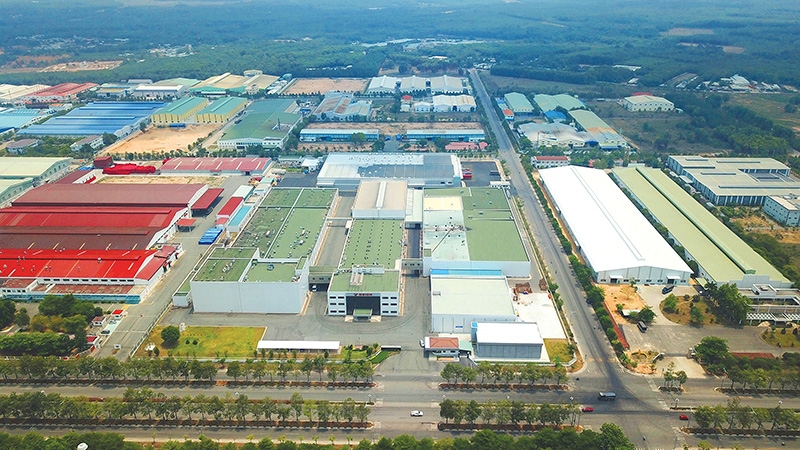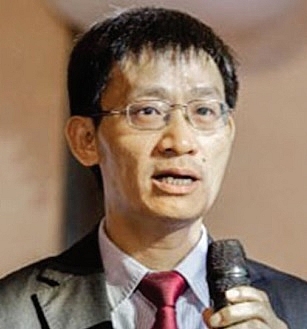Rising lease rates could discourage relocation spirit
The surging prices for industrial property land is a direct result of the rising demand in recent years. Photo: Le Toan" font-size:14px;"="">The surging prices for industrial property land is a direct result of the rising demand in recent years. Photo: Le Toan"> |
| The surging prices for industrial property land is a direct result of the rising demand in recent years. Photo: Le Toan |
Arriving in Vietnam on a hot summer’s day, Takashi, the director of a Japanese company producing electronic circuit boards, contacted consultants Ecobuy Business and Service Co., Ltd. in Hanoi for support in finding industrial land for lease, and implementing investment procedures.
Ecobuy suggested the director industrial zones (IZs) which meet his requirements from the 30 with which it has agreements with. These include a suitable location within budget and near the partner’s factory, with cheap labour force and access to raw materials, public transportation, and ports. Also required are stable electric power and water, decent tax incentives, and relevant government support.
After exchanging information on price, location, and other factors, Ecobuy and the Japanese firm visited WHA IZ in the central province of Nghe An for a decision and were surprised to learn of a sudden increase in price from $38 per square metre in the offering to $42, for 50 years of leasing.
“In Japan, businesses have to explain and apologise multiple times to customers if they want to increase prices, even a little. But in this IZ, they increase costs whenever they want, without informing partners like the consultancy firm,” said Takashi.
Demand pushes prices
The Vietnamese industrial property market has seen a surge in land and factory leasing inquiries from both existing and new players. Some of the newer free trade agreements like the Comprehensive and Progressive Agreement for Trans-Pacific Partnership and the EU-Vietnam Free Trade Agreement also enable the country to access new prospects to become a new global manufacturing hub.
Manufacturing will continue to shift out of China due to rising costs, the trade conflict with the US, and manufacturers’ strategy of reducing dependence on a single market, especially after COVID-19. As a result, rents and occupancy of industrial parks in major manufacturing cities and provinces have escalated amid limited industrial land supply.
The offering price currently at most IZs has risen around 7.6 per cent in Hanoi and 16 per cent in Ho Chi Minh City due to this increase of demand, according to a report from MB Securities JSC.
In the north of the country, costs range from $110-250 per square metre, while it can be $70-130 in Haiphong and Bac Ninh, or $60-90 in Hai Duong and Hung Yen. In the south, the price ranges between $145 and $300 per sq.m in Ho Chi Minh City, $100-190 in Long An, $70-150 in Binh Duong, $80-160 in Dong Nai, and $40-140 in Ba Ria-Vung Tau, according to CBRE Vietnam.
“The $100 per sq.m, which was deemed expensive, has already risen to $150, which is an unbelievable price,” said Do Nhat Hoang, director general of the Ministry of Planning and Investment’s Foreign Investment Agency (FIA).
The FIA highlighted some IZs which pushed prices high, such as Protrade, Nam Dinh Vu, WHA, and Viglacera. Experts attributed this to the market movements in the current global context.
Talking with VIR, David Nardone, group executive, Industrial and International of WHA Industrial Development Plc. said that WHA IZ in Nghe An had the same introductory price for the first three years during the approval, relocation, landfill, and development process. “Now that the first phase is complete and at an excellent infrastructure and environmental standard, the lease is only about 10 per cent higher – a fraction of the price in the congested northern and southern areas that could charge three times our rate,” Nardone said.
Director of Ecobuy Tran Quang Hoi said that price is usually adjusted by the relationship between supply and demand. “If the demand enhances too high for supply to meet, the price will be modified, especially in first-tier cities and provinces in the key economic regions in the south and north,” Hoi said. “This is a part of the total investment of every financier, which will surge if land leasing grates escalate. So investors will consider carefully before pouring money into Vietnam or other countries.”
Indeed, Takashi returned to Japan to rethink the investment destination, with FIA director general Hoang claiming that the massive increase of prices in IZs will hamper the country in seizing the opportunities ahead.
Creating success
The increasing rents, limited approvals, and projects under construction at industrial parks pose the question of whether Vietnam can successfully attract foreign investment.
According to Dang Trong Duc, general director of KTG Industrial, a member of Khai Toan Group (KTG), the limited space will be creating difficulties for incoming investors when they move to Vietnam.
“The main competitors to Vietnam, like India and Indonesia, have also been preparing actively for land funds to welcome movement from other countries. The competition is very tough and Vietnam must improve its administrative procedures and investment environment if it wants to win in this campaign,” Duc said.
Hirai Shinji, chief representative of the Japan External Trade Organization in Ho Chi Minh City, also agreed that administrative procedures and transparency were two issues Japanese enterprises are most concerned with when they come to Vietnam.
Other issues are the reduction of incentives (such as personal income tax in economic zones), complicated investment license procedures, fire prevention, a shortage of power, and unclear regulations on power use regulation.
“Moreover, Japanese investors are facing difficulties in understanding the legal framework and are held up by the slow process of infrastructure improvement,” Shinji said.
Regulations on used-equipment imports should be loosened and made more transparent, he added, while the laws on public-private partnerships must be completed to remove all obstacles for investors.
Many warehouse facilities in Vietnam today remain behind the times and they need to be upgraded with advanced and smart technology to meet growing demand from tenants, Shinji explained.
CBRE Vietnam in a press release earlier this month stated the abrupt transition of manufacturing companies to Vietnam will create bottlenecks in industrial property supply.
Investors and developers will not have enough time to provide quality and sufficient properties for coming occupiers because developing a new industrial project will be very time-consuming, especially in terms of legal works.
The statement added that the temporary lack of labour force and low-quality infrastructure network will possibly restrain the growth prospect of the market in the short run.
Confronting the challenges, developers that already have land are encouraged to accelerate the construction of ready-built factories to prepare for expansion opportunities.
What the stars mean:
★ Poor ★ ★ Promising ★★★ Good ★★★★ Very good ★★★★★ Exceptional
Related Contents
Latest News
More News
- Vietnam’s green transition demands collective financial action (December 15, 2025 | 12:00)
- VIR workshop highlights capital and policy for sustainable development (December 15, 2025 | 11:00)
- National Assembly approves pilot mechanisms to accelerate major projects in Hanoi (December 12, 2025 | 11:29)
- Vietnam eases policy approval requirements, simplifies foreign and outbound investments (December 11, 2025 | 17:53)
- Unpacking new momentum in Vietnam’s M&A market (December 10, 2025 | 09:59)
- Forum honours outstanding M&A deals, strategies, and advisory firms (December 09, 2025 | 18:22)
- Vietnam enters defining phase of M&A growth (December 09, 2025 | 17:00)
- Vietnam’s M&A market opens new opportunities amid strong economic momentum (December 09, 2025 | 15:00)
- Vietnam M&A Forum 2025: new position, new momentum (December 09, 2025 | 14:30)
- FDI in Vietnam jumps on additional capital and share purchases (December 09, 2025 | 13:56)







 Tag:
Tag:






















 Mobile Version
Mobile Version